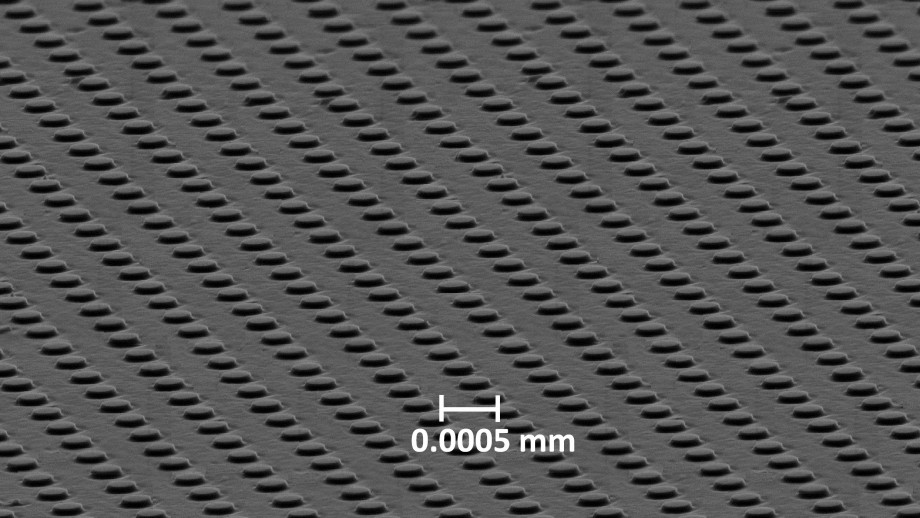Invented film that protects against cosmic radiation

The sample inside contains hundreds of thousands of nanoparticles that interact with transmitted light. Photo: Stuart Hay, Australian National University
One of the main obstacles to the colonization of Mars and any other manned space missions is dangerous space radiation. During the flight to Mars, astronauts will be exposed to high-energy highly ionized particles known as cosmic rays of galactic and solar origin (GCR and SCR).
Andrei Miroshnichenko, Andrei Komar, Sergei Kruk, Yuri Kvishar and colleagues (all from the Center for Nonlinear Physics at the Research School of Physics and Engineering at the Australian National University) under the leadership of Dr. Mohsen Rahmani invented a nanomaterial with unusual physical properties. Scientists believe that these properties can be used including for partial protection of space suits and satellites from space radiation.
By the number of particles, cosmic rays are 92% composed of protons, 6% are helium nuclei, about 1% are heavier elements, and about 1% are electrons. The energy spectrum of cosmic rays by 43% consists of the energy of protons, another 23% - of the energy of helium (alpha particles) and 34% of the energy transferred by the other particles. Due to the extremely high energy of more than 10 MeV, these particles pass through the lining of the spacecraft and through the soft tissues of astronauts, including the brain. In the human body, ionizing radiation causes a variety of damage at the molecular level, including disrupting cell repair processes and slowing down the healing of damaged tissues. GCRs cause disturbances in the nervous system, including long-term impairment of mental abilities due to the simplification of the dendritic structure, changes in the levels of protein in synapses, and inflammation of the nervous tissue ( experiments were performed on mice ).
NASA and research teams around the world are now looking for a way to create the most effective protection against space radiation. The most direct approach for such protection is a thick layer of some material that absorbs cosmic rays. A group of Australian scientists offer a radically different way: their material does not absorb, but scatters radiation. They describe it in more detail in their scientific article “Reversible Thermal Tuning of All-Dielectric Meta-Surfaces” (Reversible Thermal Tuning of All-Dielectric Metasurfaces).
The meta-surface is a two-dimensional structure of nanoparticles or microparticles located in space according to a certain law at distances smaller than the wavelength . Meta-surfaces are used in photonics to change the front and phase of the incident electromagnetic radiation according to a given law. Of particular interest are meta-surfaces, in which particles change the index of refraction depending on the external influence - light, magnetic field or temperature.
In this case, the dielectric meta-surface reflects or transmits light depending on the refractive index of silicon, which depends on temperature. That is, its properties can be controlled by heating or cooling the surface. Scientists have shown how to achieve a clear resonance due to the interference between the regimes of a magnetic dipole and an electric quadrupole in a specially composed 2D lattice of nanoparticles.

By controlling the temperature, one can control this resonance and cause directional scattering (i.e., scattering in a narrow angle) from the meta-surface in the 75-nm spectral window. This can lead to a 50-fold increase in radiation anisotropy (radiation directionality). The authors believe that such a reversible change in material properties can be useful in different areas, including meta-lenses and meta-holograms . The film changes the refractive index (transparent or opaque), including in the visible light range, so that it can be used in interior design - to cover windows (instead of curtains or blinds), in cars, etc. Also, these meta-surfaces can be used at least for partial scattering of cosmic rays.

Associate Professor Andrei Miroshnichenko (left) and Dr. Mohsen Rahmani, the leading authors of the scientific work, demonstrate a new nanomaterial. Photo: Stuart Hay, Australian National University
A thin film of this metamaterial is applied to any surface, including suits. “Our invention has many potential applications, such as protecting astronauts or satellites with a super-thin film that can be tuned to reflect dangerous ultraviolet or infrared radiation in different environments,” says Dr. Rahmani. “This technology significantly increases the threshold of resistance against harmful radiation compared to modern technologies that rely on radiation absorption in a thick layer [of substance].”
It is difficult to imagine how a practically two-dimensional film will protect against high-energy gamma particles with an energy of 10 MeV. Probably not possible. Maybe the film is able to reflect / scatter particles / waves with less energy. In any case, the material is useful if it is really more effective than a thick layer of lead or water, as scientists say.
The scientific work was published on July 3, 2017 in the journal Advanced Functional Materials (doi: 10.1002 / adfm.201700580).
All Articles